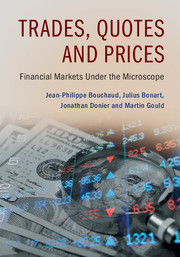Book contents
- Frontmatter
- Dedication
- Contents
- Preface
- Acknowledgements
- PART I HOW AND WHY DO PRICES MOVE?
- PART II LIMIT ORDER BOOKS: INTRODUCTION
- PART III LIMIT ORDER BOOKS: MODELS
- PART IV CLUSTERING AND CORRELATIONS
- PART V PRICE IMPACT
- PART VI MARKET DYNAMICS AT THE MICRO-SCALE
- 13 The Propagator Model
- 14 Generalised Propagator Models
- PART VII ADVERSE SELECTION AND LIQUIDITY PROVISION
- PART VIII MARKET DYNAMICS AT THE MESO-SCALE
- PART IX PRACTICAL CONSEQUENCES
- Appendix
- Index
- References
14 - Generalised Propagator Models
from PART VI - MARKET DYNAMICS AT THE MICRO-SCALE
Published online by Cambridge University Press: 26 February 2018
- Frontmatter
- Dedication
- Contents
- Preface
- Acknowledgements
- PART I HOW AND WHY DO PRICES MOVE?
- PART II LIMIT ORDER BOOKS: INTRODUCTION
- PART III LIMIT ORDER BOOKS: MODELS
- PART IV CLUSTERING AND CORRELATIONS
- PART V PRICE IMPACT
- PART VI MARKET DYNAMICS AT THE MICRO-SCALE
- 13 The Propagator Model
- 14 Generalised Propagator Models
- PART VII ADVERSE SELECTION AND LIQUIDITY PROVISION
- PART VIII MARKET DYNAMICS AT THE MESO-SCALE
- PART IX PRACTICAL CONSEQUENCES
- Appendix
- Index
- References
Summary
When I want to understand what is happening today or try to decide what will happen tomorrow, I look back.
(Omar Khayyám)Price Micro-Mechanics
In the previous chapter, we studied a class of propagator models that consider the change in mid-price that occurs between subsequent market order arrivals. The models that we studied in that chapter consider all market order arrivals on an equal footing, irrespective of their size and how aggressive they are.
In the present chapter, we extend those models in two different ways. First, we consider a propagator model that partitions market order arrivals according to whether or not they consume the entire opposite-side best queue upon arrival. We introduce a mathematical framework that enables us to distinguish the impact of orders partitioned in this way, and we show that this extension helps to solve some of the problems with the one-event-type propagator models from the previous chapter.
Second, we introduce a generalised propagator model that considers not only market order arrivals, but also some limit order arrivals and cancellations. In this framework, we are able to track all events that cause price changes, and we are therefore able to monitor the evolution of impact on a more microscopic scale. However, we also argue that performing such a granular analysis of order flow requires working with rather complex models, which can be difficult to calibrate. We then turn to a more intuitive formulation of these multi-event propagator models that naturally encompasses the idea of history-dependent liquidity.
Limitations of the Propagator Model
The propagator model that we introduced in Chapter 13 is a reduced-form description of LOB dynamics. The model assumes that all market orders lead to the same impact dynamics, characterised by the propagator G(l), and does not explicitly track other LOB events that occur between market order arrivals. Clearly, this approach neglects many effects that could be useful for understanding or modelling price changes in real LOBs. For example, partitioning market orders according to whether or not they consume all the available liquidity at the opposite-side best quote is very useful, not only for assessing whether such market orders will cause a change in mid-price immediately upon arrival, but also for predicting the string of other LOB events that are likely to follow.
- Type
- Chapter
- Information
- Trades, Quotes and PricesFinancial Markets Under the Microscope, pp. 270 - 286Publisher: Cambridge University PressPrint publication year: 2018



